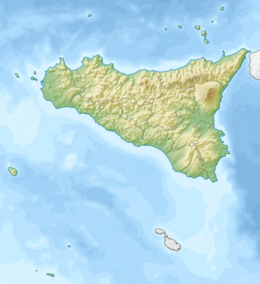 | |
| Local date | 11 January 1693 |
|---|---|
| Local time | 21:00[1][2] |
| Duration | 4 minutes |
| Magnitude | 7.4 Mw |
| Epicenter | 37°18′N 15°06′E / 37.3°N 15.1°E[3] The exact location of the epicentre remains uncertain |
| Areas affected | Southern Italy, notably Sicily, and Malta[4] |
| Max. intensity | MMI XI (Extreme)[5] |
| Tsunami | 5–10-metre high waves devastated the coastal villages on the Ionian Sea and in the Straits of Messina. (Ambraseys-Sieberg intensity V tsunami) |
| Foreshocks | A magnitude 6.2 on 9 January[5] |
| Casualties | 60,000 deaths[6] |
The 1693 Sicily earthquake struck parts of southern Italy near Sicily, then a territory part of the Crown of Aragon by the Kings of Spain Calabria, and Malta on 11 January at around 21:00 local time.[1] This earthquake was preceded by a damaging foreshock on 9 January.[7] The main quake had an estimated magnitude of 7.4 on the moment magnitude scale, the most powerful in Italian recorded history,[8] and a maximum intensity of XI (Extreme) on the Mercalli intensity scale, destroying at least 70 towns and cities, seriously affecting an area of 5,600 square kilometres (2,200 sq mi) and causing the death of about 60,000 people.[5][6]
The earthquake was followed by tsunamis that devastated the coastal villages on the Ionian Sea and in the Straits of Messina.[9] Almost two-thirds of the entire population of Catania were killed.[5] The epicentre of the disaster was probably close to the coast, possibly offshore, although the exact position remains unknown. The extent and degree of destruction caused by the earthquake resulted in the extensive rebuilding of the towns and cities of southeastern Sicily, particularly the Val di Noto, in a homogeneous late Baroque style, described as "the culmination and final flowering of Baroque art in Europe".[10]
According to a contemporary account of the earthquake by Vincentius Bonajutus, published in the Philosophical Transactions of the Royal Society, "It was in this country impossible to keep upon our legs, or in one place on the dancing Earth; nay, those that lay along on the ground, were tossed from side to side, as if on a rolling billow."[1]
- ^ a b c Bonajutus, V. (1694). "I. An account of the earthquakes in Sicilia, on the ninth and eleventh of January, 1692/3. Translated from an Italian letter from Sicily by the noble Vincentius Bonajutus, and communicated to the Royal Society by the learned Marcellus Malpighius, physician to his present Holineß". Philosophical Transactions of the Royal Society of London. 18 (207): 2–10. doi:10.1098/rstl.1694.0001.
- ^ USGS: "1693 01 11 – Sicily, Italy – M 7.5 Fatalities 60,000" Archived 2010-07-28 at the Wayback Machine
- ^ National Geophysical Data Center / World Data Service (NGDC/WDS): NCEI/WDS Global Significant Earthquake Database. NOAA National Centers for Environmental Information (1972), Significant Earthquake Information, NOAA National Centers for Environmental Information, doi:10.7289/V5TD9V7K, retrieved 30 March 2022
- ^ Galea, P. (2007). "Seismic history of the Maltese islands and considerations on seismic risk". Annals of Geophysics. 50 (6): 725–740. doi:10.4401/ag-3053.
- ^ a b c d Cite error: The named reference
CFTI5MEDwas invoked but never defined (see the help page). - ^ a b Rodríguez de la Torre, F. (1995). "Spanish sources concerning the 1693 earthquake in Sicily" (PDF). Annali di Geofisica. 38 (5–6): 526. doi:10.4401/ag-4054., Juan Francisco Pacheco y Téllez-Girón, 4th Consort Duke of Uceda the Spanish Viceroy of Sicily at the time reports ((...) and about sixty thousand people died under the ruins of the earthquake)(August 4, 1695)
- ^ Gutscher, M.-A.; Roger, J.; Baptista, M.-A.; Miranda, J. M.; Tinti, S. (2006). "Source of the 1693 Catania earthquake and tsunami (southern Italy): New evidence from tsunami modeling of a locked subduction fault plane" (PDF). Geophysical Research Letters. 33 (8): L08309. Bibcode:2006GeoRL..33.8309G. doi:10.1029/2005GL025442. S2CID 32098099.
- ^ Cite error: The named reference
Armigliatowas invoked but never defined (see the help page). - ^ Piatanesi, A.; Tinti, S. (1998). "A revision of the 1693 eastern Sicily earthquake and tsunami" (PDF). Journal of Geophysical Research: Solid Earth. 103 (B2): 2749–2758. Bibcode:1998JGR...103.2749P. doi:10.1029/97JB03403.
- ^ "Late Baroque Towns of the Val di Noto (South-Eastern Sicily)". World Heritage List. UNESCO. Retrieved 22 November 2011.

